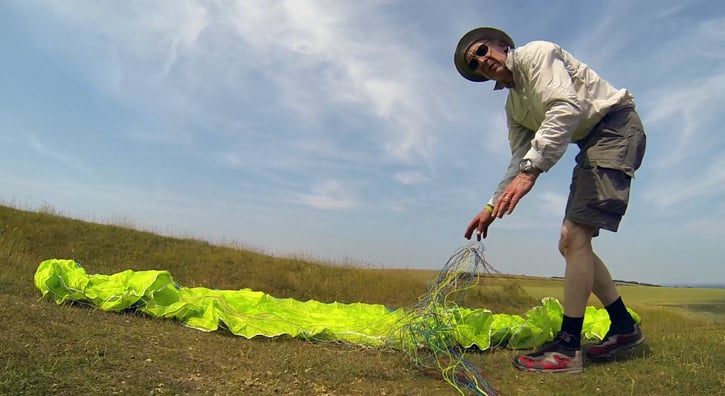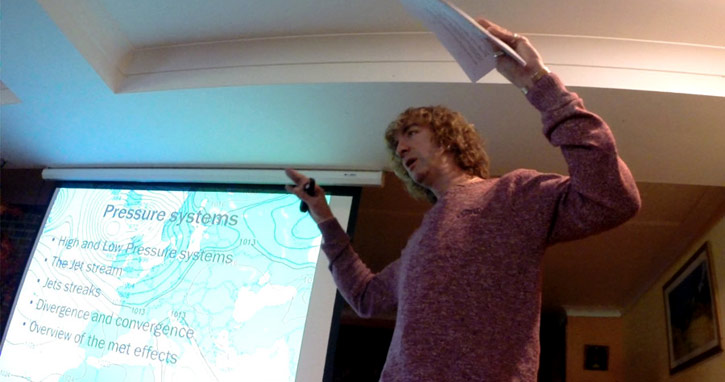
It’s exciting being on launch, especially if your friends are flying! The wind is increasing – you’ve got to get in the air! You’ve got to get in the air! You hurry it all out of the bag, throw on the harness, and fluff out the wing like a startled chicken. Ready? Steady. Stop!
When you arrive on the launch site, you should be doing a Daily Equipment Inspection. Check the wing for damage, clear the lines of any tangles, check the riser maillons, speedbar connectors and ensure your complete kit is prepared – off the main launch area.

^ Ed inspects the subtle signs of a visitation by the Flying Spaghetti Monster
You might not notice experienced pilots doing this, because they are very familiar with the procedure and can achieve it very quickly. They inspect their reserve handle pins as they don their harness; they inspect the wing as they draw it open; they check the lines as they bunch it up. When you’re a low-airtime pilot or out of practice, these habits might not be ingrained, so train yourself by never skipping the inspection.
If it was an unfamiliar site, you’d also be well served by finding an experienced pilot and doing a Site Assessment. Have a good look at the local weather, the wind on launch, hazards, traffic flow, toplanding approach patterns, landing fields and emergency options.

^ There are probably better places to launch
It was probably your good Weather Assessment that brought you to the hill in the first place, so we can assume that you know the forecast for the day, and if there are any hazards like increasing wind or inclement weather on the horizon. Compare the forecasts to what you see. It helps you to establish the risk posed by changeable conditions, and also helps you identify which forecast services are unreliable in your area.

^ Weather guru Barney Woodhead recommends worship
So you’ve done all your assessments. You’ve found a good position on the main launch area and laid your wing out nicely. You’ve checked that you’re connected without any twists or tangles, and you’re about to fly. Now you’re ready for your
Preflight Checks
I like a 5 Point Check system, which is effective because it’s memorable and simple. You can remember five things without mnemonics or complicated acronyms. Imagine your instructor holding up a hand just as you’re about to plunge off the edge. Whoa!
.jpg)
^ Wait, it’s movie time! Carlo tries to remember his lines.
Check! One for each finger:
1. Helmet
Is it in place, and is the chin strap secured?
2. Harness
Are all the connections connected? Start with your legstraps and move up through the straps and buckles, testing the carabiners as well for good closure.
3. Risers
The riser lying on top will indicate the way you must turn. Run your eye along its length to its carabiner to establish the turn direction. Gather the risers you normally use for launching and check for twists. The slightly tensioned lines must run clear to the wing. Also check for the deadly twisted brake line, which can lock up your controls. The line must be running freely through its pulley.
4. Wind
This one is often missed, because pilots think they know what it is doing based on what was happening when they arrived. Or maybe it’s because one can’t see the wind, so it just gets a vague glance over the shoulder. If you’re standing with your back to the wind (reverse pullup) the windsock stuck at the back of the launch area is not much use. It tells you what the wind was. Turn all the way around and scrutinise the vegetation down slope of you (or even better, another windsock). Try to establish the wind speed, wind direction, wind gradient, gustiness and thermal cycles. This is your moment to get fully focused on the air ‘out there’ and become aware of where you are going to be. Watch any wings flying for signs of penetration problems or turbulence. Look out for grass whipped up in a dustdevil. Timing your launch is an important skill, but if you don’t look for the signs before you launch, you can’t improve it.
5. Traffic
You might fly uncrowded sites but it’s important to establish the check so it becomes a habit. This makes all the difference when you actually need it (the first time you fly a crowded site, when you’re tired from a long journey to a new competition, and the conditions are booming … or whatever challenge it is). We all have momentary lapses of concentration. Hard-wired habits can help avoid a disaster. So check this every time to help develop your routine of good Preflight Checks.
Watch the accompanying video...
Brought to you by Flybubble
Want to see more? There’s no better way to support our efforts than buying from us. We’ll ensure you get great service! Choose from our great range AND enable us to produce more content to benefit the freeflight community.

